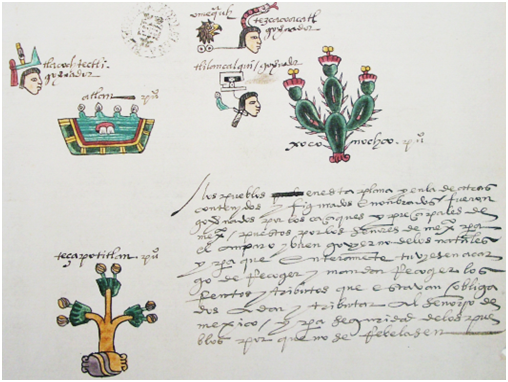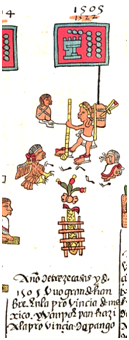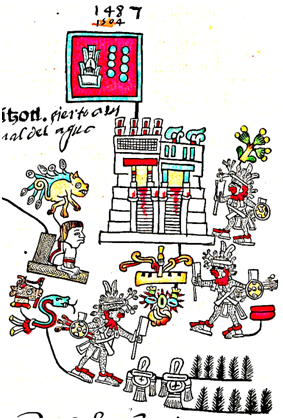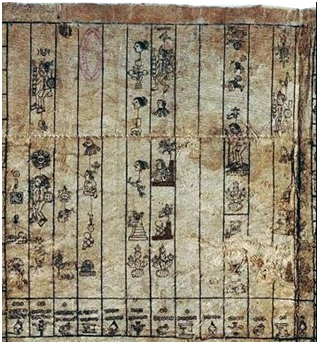Journal of
eISSN: 2573-2897


Research Article Volume 4 Issue 1
Centro Universitario del Norte Mexico
Correspondence: Emmanuel M rquez Lorenzo Centro Universitario del Norte Mexico, Tel 3328126367
Received: January 11, 2019 | Published: February 11, 2019
Citation: Lorenzo EM. Tetzapotitlan: the toponym of the preterite society of castillo de teayo. J His Arch & Anthropol Sci. 2019;4(1):26-31. DOI: 10.15406/jhaas.2019.04.00176
This work is focused on presenting evidences that support the identification of Castillo de Teayo with the ancient society of Tetzapotitlan. For this, an arduous investigation has been carried out that required the revision of a multitude of pictographic and written documents, as well as archaeological evidences. As a result, the toponymic identification has been successfully achieved, which has allowed and will allow the subsequent realization of further research at the archaeological site of Castillo de Teayo, located in southern Huaxteca.
Keywords: tetzapotitlan, castillo de teayo, toponym, glyphs
During the second half of the fifteenth century of our era, Mexica society reached a remarkable expansionist degree, to the extent of affecting many contemporary societies. Among them, the populations of the Gulf Coast, which were recurrent prey of the tax impositions that demanded, by the peaceful way, gifts to Huitzilopochtli, and by means of warlike actions, the direct extraction of elaborated products, with or without calpixques responsible for the collection, administration and shipment of such goods to Mexico Tenochtitlan. Apparently, the behaviors of the Mexican authorities were different for their subject peoples. Researchers such as Berdan and Smith, for example, have proposed the existence of two peculiar types: "tributary", in which the interaction was reduced to the granting of goods from time to time;1 and "strategic", "frontier" or "patronage", where the headers were taken with the purpose of protecting borders with respect to other peoples less susceptible to domination.2 However, there is apparently a particular form that has been little studied, except perhaps for the work carried out by Ohnersorgen in Cotaxtla,3 in which it has been proposed that the physical presence of Mexican civil and military authorities in conquered sites could have affected traditional cultural behaviors. Under this last behavioral observation, physically evident in many archaeological materials, such as Mexican and Texcocan ceramics, representations of Altiplano deities in monumental sculpture and figurines, architectural modifications and greater presence of green obsidian, the study has not only been studied the region of Cotaxtla in the south of Veracruz,4 but also that of the southern Huaxteca, competing in particular with the current site of Castillo de Teayo. For now, however, the work has been restricted to presenting information associated with the former place name of the locality, based on the analysis of various documents.
LocationThe municipal seat of Castillo de Teayo is located in the north of the state of Veracruz, within the Huaxtec region, at 20º 45’ north latitude and 97 º 38’ east longitudes and has elevations lower than 100 meters above sea level. It limits by the north with the municipality of Temapache, to the east with the one of Tihuatlán and to the south and the west with the State of Puebla (Figure 1). The archaeological site is also located on the elevations belonging to the volcanic Neo Axis, between the Sierra Madre Oriental and the Gulf of Mexico.
Historical background of castillo de teayo The current name of the town arose in 1872, when neighbors of the town of Tihuatlán decided to occupy the land of the former hacienda of Teayo -located between 2 and 3 km to the west-. As a result of the fires of grasslands, the discovery of a large number of monumental sculptures is presented, as well as a pyramidal basement, which is called the "Castle". In order to differentiate its population from the one already existing in Teayo, they are called Castillo de Teayo.5 But before the date indicated, only data referring to a Huaxtec people called Tetzapotitlan, which was "in the village of Metateyuca" and "Camino de Pánuco". These are included as part of the taxes that the population of the town had to deliver, starting in 1546 and stopping in 1566, during which there was a considerable reduction in the required payments and in its delivery time, because there was a reluctant tendency to the encomienda, in addition to the town was depopulated until abandoned.6 By contextualizing historically, it is possible to understand the sudden abandonment of several villages of the Huaxteca, due to several factors: pests, wars, slave trade (both by Spaniards and Huaxtec lords), work and excessive tribute payments by the Spanish, in addition to the mistreatment they received from the latter.7 For many years, it was a complex problem to find out the name of the old town of Castillo de Teayo, even more so because there was a certain degree of speculation in the interpretation of Los Lienzos de Tuxpan by Melgarejo,6 considering the type of proposals characteristic of his other works. It was not, however, until repaired in the glyphs present in an archaeological monument of the town, when it was possible to corroborate that, indeed, the place name Tetzapotitlan was the one corresponding to Castillo de Teayo.
The toponym of tetzapotitlan in pictographic documents Melgarejo identifies the name of Tetzapotitlan with the current locality of Castillo de Teayo in Los Lienzos de Tuxpan, based on the geographical situation shown in these different codices (Figure 2). According to Hill, the original local map of Tochpan (Figure 3), "of clear Aztec style" and first of a series of six such documents, would be the expression of a war waged by Tochpan against the other populations, which would have occurred in a year 13 Técpatl, basing his proposal by the presence of a shield settled on four spears, and the pointing of footprints that go from Tochpan to the other locations.8 On the other hand, the toponym of Tetzapotitlan, present in Los Lienzos de Tuxpan, is totally identifiable in the First Regional Map (Figure 4a), possibly painted in the year of 1499; moderately on the Second Regional Map (Figure 4b), which is a copy of the first; and only by the representation of a part of the glyph (Figure 4c), in a copy of another pictographic document made in the mid-sixteenth century.9 Although Melgarejo does not mention it explicitly in his work, it is very possible that his proposed identification was based on the previous analysis of other better known pictographic documents, such as the Codex Mendoza and the Matrícula de Tributos. This is inferred because in them, the place name Tetzapotitlan is associated with that of Atlan (Figure 5), the latter corresponding to that of a current population of the northern highlands of Puebla. In this way, it is clear that Tetzapotitlan should be at a medium distance from Atlan, besides being a very important town, because it was paying, like the vast majority of provinces of the southern Huaxteca, cotton blankets. In continuity with this reasoning, these data should be considered in relation to the large number of sculptures of Mexican deities found by Seler in the year 1902 in the town of Castillo de Teayo. This would be the fundamental step to relate the correspondence of a relatively new locality with an already disappeared some hundreds of years ago. And not only it would be an inference that supports the identification of Tetzapotitlan, but also Seler himself affirms, from the analysis of the pieces found in the locality, a unique peculiarity of the material culture found "We can also assume that the total Devotion in this city as a Mexican province is a reflection-to some extent-of the elaborate ceremonies held in the capital, which are detailed in the records of Bernardino de Sahagún and other authors.”10 This referring, of course, to the ritual paraphernalia that should have involved the sculptural production of Castillo de Teayo (Tetzapotitlan) with the rituals celebrated in the past. Based on this, and resorting to the direct observation of the pictographic documents indicated above, we observe characteristics peculiar to the ancient society of Tetzapotitlan. On the one hand, as a tax society, dependent on Atlan (Figure 5), and on the other, as a result of a phenomenon of territorial occupation and colonization (Figure 6). Both situations, caused by the own defensive attitudes of the natives of the region, who stayed within processes of rebellion and new conquests during a period of at least thirty years.11 Therefore, and taking into account the data presented up to this moment, it is possible to deduce what other researchers inferred at the time: the existence of a site named Tetzapotitlan in the southern border of Huaxteca, near the town of Atlan and bordering with the corregimiento of Metlaltoyuca, which presented, as the Codex Mendoza states, a Mexican territorial occupation. The identification of this town with that of Castillo de Teayo, then, is suggested by the multiple archaeological materials of Mexica style found in the locality -especially sculptures-, and that many researchers have attributed to the presence of an enclave in the area.12 The evidences of such colonization are expressed by numerous sculptures in Seler's work, which, for the most part, are of a particular Mexican style. Also, a large number of the deities represented in them are also, to the extent that, in some cases, they are identical copies (Figure 7), judging based on the image, dimensions, type of rock used and even weight.13 The pictographic documents, meanwhile, continue to show evidence of colonization in the town of Tetzapotitlan (which is corroborated archaeologically, according to what has been presented in other works).14 The Codex Telleriano-Remensis, for example, exposes a famine suffered in the Altiplano during the year 13 Calli (1505), which led to the transport of food from this population (Figure 8), located on the road to the province of Pánuco. With this image, the clear ownership of the indicated territory and its assets is shown to the Mexican authorities, who benefited from local resources through the administrative exercise of the calpixques. But the history of Castillo de Teayo is even deeper, and it remains to expose the way in which Tetzapotitlan happened to be in this situation. For this, it is pertinent to start pointing out a previous execution of mass sacrifices of warriors from this town and others, according to various documents, both pictographic and written, were villages reluctant to extract tributes, which were kept in processes of rebellion and new conquests for several years. This event occurred during the erection of a new constructive stage of the Templo Mayor de Mexico Tenochtitlan, in the year 1487, as shown in the Codex Telleriano-Remensis (Figure 9) and the Códice en Cruz (Figure 10). The decisive document for the toponymic identification, however, is a monument of conquest, cataloged as the number 4 of the locality, and which contains two dates, one of which commemorates the subjugation of the site at the hands of Mexica hosts, in the 1480. In the monument, the glyph variant is something peculiar, but it is undoubtedly the double image of a tetzapotl (mamey), from which derives the meaning of the place name as "place of mameyes" (Figure 11). In this case, the meaning of the repeated image alludes to the plural, as Galarza points out in one of his works, referring to the glyphs that show this quality.

Figure 6 Tetzapotitlan, designated as a province affected by territorial occupations of the Triple Alliance.

Figure 8 Procurement of supplies brought from the province of Tetzapotitlan, which was territorially occupied.

Figure 9 Sacrifice of warriors of Tetzapotitlan, Cuetlaxtlan and Tzicoac, and installation of the Temple of Huitzilopochtli between tzicoacas and Mazatecas.

Figure 10 Representation of the erection of a new constructive stage of the Templo Mayor and sacrifice of individuals from Tetzapotitlan, Cuetlaxtlan and Tzicoac in the Códice en Cruz.
Although this sculptural piece had shown interest for several researchers until before 2012, the interpretation given to the monument was quite varied, and had focused only on the calendrical glyphs it contains.1 Nobody had noticed that in a technical report of 1944, Garcia had pointed out the possibility that the front of the sculpture showed the name of some locality.2 By direct comparison of this repeated glyph, with the present in Mexican pictographic documents, it is possible to establish the proposed identification, which has been developed in another work.15 It should also be noted that this inference can be based on any gloss displayed next to the toponym, but one of the most useful images that differentiates the glyph tetzapotl (mamey) from tetl (stone), is one from the Codex Mendoza, where it is representing the fruits of the tree (Figure 12).

Figure 12 The glyph tetzapotl representing the fruits of the tree that makes up the toponym Tetzapolco or Tetzapotitlan.
However, there is still a doubt regarding the image in this last document, because if it is judged based on the writing of the tlacuilo and not that of the commentator, the true name of the town would be Tetzapolco (composed of tetzapotl and quihuitl), that is, tetzapotes tree. The only objection to this observation, on the other hand, resides in that in the written documents the name Tetzapolco does not appear, while the Tetzapotitlan name is found in all the ones investigated so far. On the other hand, we know that Axayácatl-between 1469 and 1481-, exercises favorable militarist actions against the provinces of Tetzapotitlan and Tochpan, among others.3 The precise date of this event is possible to infer from the Códice en Cruz, which presents, for the year 1476, a variant of the place-name of Tetzapotitlan associated with the figure of a warrior, of possible Tzicoaca affiliation (Figure 13).
Tracing data referring to the study area, it is only necessary to mention some important last indications, from which the process of militarist domination of the Huaxteca Meridional seems to have begun. During the government of Moctezuma Ilhuicamina there was a massacre of Mexica merchants,16 which was attributed to residents of Tzicoac and Tochpan.17 Thus, for the year 1458, Tzicoac becomes tributary province of the Triple Alliance, according to the Codex Telleriano-Remensis.4
1García Payón José, Castillo de Teayo. Noticias sobre su arqueología. UNI-VER. Órgano de la Universidad Veracruzana 16, Tomo II, Xalapa, 1950, p.56; García Payón José, Descripción del pueblo de Gueytlalpan (Zacatlan, Juxupango, Matlaltan, y Chila, Papantla). Juan de Carrión Alcalde Mayor. Cuadernos de la Facultad de Filosofía, Letras y Ciencias de la UV, Xalapa, 1965 [1581], p.78; García Payón José, Arqueología de la Huasteca. Consideraciones generales. En Los pueblos y señoríos teocráticos. El período de las sociedades urbanas, coordinado por Román Piña Chán. Col. México, Panorama histórico y cultural VIII, 2da. Parte. INAH, México, p. 261; García Payón José, Evolución histórica del Totonacapan. En Huaxtecos y Totonacos. Una antología histórico-cultural, compilado por Lorenzo Ochoa, CONACULTA, México, 1989, p.233; Melgarejo Vivanco José Luis, La provincia de Tzicoac. EDITIV 6. Xalapa, 1944, p.23; Melgarejo Vivanco, óp. cit., p.21; Melgarejo Vivanco José Luis, Antigua Historia de México. Tomo III. Col. Documentos, SEP, México, 1976, pp.150-151; Melgarejo Vivanco José Luis, Huaxteca Veracruzana (Época Nativa), Gobierno del Estado de Veracruz, colección Pensamiento y Palabra de Veracruz, Xalapa, 1998, p.121; Seler, óp. cit., p.214; Umberger Emily, Historia del arte e Imperio Azteca: La evidencia de las esculturas. Traducido por José Luis de Rojas. Revista Española de Antropología Americana 37(2), 2007, p.184
2García Payón José, Impresiones de mi primera visita a la zona arqueológica de Castillo de Teayo, Ver. Archivo Técnico del INAH, Tomo CXVIII, Estado de Veracruz. Varios. Vol. I 1922-1948, 879.-5.-, 1944, p.3
3The Codex Mendoza, Editado por Frances F. Berdan y Patricia Rieff Anawalt, Volume III: Facsimile. University of California Press, Berkeley-Los Angeles-Oxford, 1992.
4Códice Telleriano-Remensis (Ritual, Divination, and History in a Pictorial Aztec Manuscript), editado por Eloise Quiñones Keber, University of Texas Press, Hong Kong, 1995, f. 33r.
Based on what has been said along these pages, we have been able to contribute to the knowledge of the past society of Castillo de Teayo, at the time known as Tetzapolco or Tetzapotitlan. However, the exposure of the information contained in the sources consulted, both written and pictographic, should not be assumed without criticism, and for now they have only allowed knowing part of the cultural phenomena that the people were facing towards the second half of the year, fifteenth century of our era. In the absence of extensive and intensive archaeological research in the area, the outline presented here has a fundamental role, because it allows not only to formulate a diversity of hypotheses, but also to submit them to contrast once they are made. In this way, we know that the current locality was founded in 1872, by settlers from the neighboring town of Tihuatlán. Before that date, there is a gap of documentation covering at least three hundred years, because there are only previous mentions between the years 1546 and 1566, in which the taxes requested and the problem of depopulation of the locality are exposed because of the payment request to the Hispanic parcels.
The way in which it has been possible to link Castillo de Teayo with Tetzapotitlan is somewhat complex, and required not only to observe in detail the position of the place-name in Los Lienzos de Tuxpan, but also the characteristics that are associated in documents such as the Codex Mendoza, where specifies the Mexica territorial occupation suffered by this population. These signs, together with the archaeological evidence of the locality -mostly consisting of representations of Mexican deities-, allow to link decisively to both localities. The most important document for identification, however, has been a monument found in Castillo de Teayo by Eduard Seler in 1902, and which consists of a sculpture that commemorates the conquest of Tetzapotitlan in the year 1480. The territorial occupation suffered by Tetzapotitlan seems to be revealed also by the carrying of provisions in the year 1505, in which the provinces of the Altiplano suffered a period of intense drought. The fact that they decided to bring food from Tetzapotitlan and not from another province, shows the central importance of this town and its cultural affectation, being dominated by the Mexican militaristic forces. This serious and notable presence would have been facilitated by the frequent extraction of warriors from the area, destined to be sacrificed in various events in Mexico Tenochtitlan, as evidenced by the Codex Telleriano-Remensis and the Códice en Cruz, in the year 1487, with the sacrifice of population from Tetzapotitlan for the inauguration of a new constructive stage of the Templo Mayor. Finally, it can be said that the territorial occupation of Tetzapotitlan seems to have been strategic, because the dominion over the indicated province was not made de facto from a single war movement, but seems to have occurred at various historical moments. In this way, for example, the Codex Mendoza and the Códice en Cruz allow to specify the realization of a war towards the year 1476. Before this year, however, the militaristic presence of the provinces of the Altiplano goes back to before 1458 , when the massacre of Mexican merchants takes place at the hands of Tzicoacas and Tochpanecas. We do not doubt that the population of Tetzapotitlan, located between both provinces, has been involved in these events, and that its strategic geographical position has been discovered and used later by the civic military authorities of the Mexica people.
None.
Author declares that there is no conflicto of interest.

©2019 Lorenzo. This is an open access article distributed under the terms of the, which permits unrestricted use, distribution, and build upon your work non-commercially.